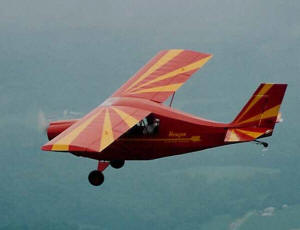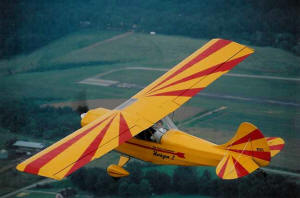Fisher Horizon 1 aircraft plans, Fisher Flying Products Horizon 2 aircraft plans.
|
|
|
|
The World's first Lightsport and Ultralight
Aircraft weekly web video webcast!
If you have high speed internet and Windows Media Player
installed you can watch our weekly Light Sport and
Ultralight aircraft webcast!
Each issue is 25 to 35 minutes in length and
is live on the web for 7 days.
Click here for more information! |
|
|
|
|
|
|
|
|
Click here for this months specials! |
|
|
 |
|
|
Click
HERE to
receive ULTRALIGHT NEWS EXTRA!
Our monthly newsletter
packed full of information about ultralight aviation!
|
|
Fisher Horizon
Project by Gary Johnson
|
Reporter Trent Sommer
Gary Johnson came from Nebraska and spent much of his working life
in Alaska. As a hobby he built custom furniture for family and
friends for a long time. In 1991 he retired and came south to Port
Angeles. While living in a mobile home west of town he built a 24 x
40 wood shop, stocked it with worthy tools and then designed 2800
square foot post and beam house. Unlike our current 2 x 6
construction methods, post and beam framing uses 8 and 10 inch beams
held together by mortise and tennon joints and large splines locked
together with wooden dowels thru the joints. Over a period of two
years Gary made the timber frame parts, cut all those joints,
numbered everything and (with a crew) assembled the frame. Erection
and assembly took two days! They live there today and it is great
house. Gary has flown in the past, and living close to Fairchild he
felt the calling. For a man that works this well in wood, he would
obviously choose a project of—wood construction.
In January of last year Gary started a homebuilt project. His Fisher
Horizon 1 is a 2 -place tandem wood and fabric airplane with a strut
braced high wing that can fold and a Continental C-85 for power. It
has a 25-foot span and gross wt is 1050 lb. He built a mockup first
to make sure that he would be comfortable in it and did alter some
things to enhance that comfort.
At a meeting a few months back we asked for project reports and Gary
said that he had finished one wing and was working on the other one.
He apparently works on it every day and things have changed! Both
wings are hanging on the wall along with both ailerons, a flap and a
half, a rudder, a stabilizer, and an elevator! Hinge points and
steel fittings have been drilled, fitted and removed to varnish and
cover the wood structure. Standing on the bench is a fuselage that
it will soon stand on its gear on the floor! The landing gear is
assembled and awaits installation. Support structure for the front
seat is on the bench and looks like a piece of furniture. There are
controls and the firewall forward stuff to go, but the way Gary
works at it I wouldn’t be shocked if it flew in the late summer.
Well, wood airframes are labor intensive, a lot more effort to
build. You have to cut, fit and glue a lot of pieces together to
make one rib—and there are a lot of ribs. The Horizon wing even has
a latticework of geodetic reinforcement (on both the upper and lower
surfaces). It is attached to the inside of the rib cap strips to
serve as drag and anti drag support. The spar is a built up ”I’ beam
with fairly large chords and a thin plywood web. The whole wing
panel is very light and strong. The leading edges are skinned with
plywood—three plies, totaling 1/32” in thickness! A wooden wing is
an intricate and beautiful thing. It almost seems a shame to cover
it
The body is built like a model airplane, with a frame of about 3/4
inch square wood strips for longerons, vertical and diagonal
members, covered with a 1/8” Birch plywood on the outside. The
inside frames are made of similar materials and the whole look is
that of a really big radio controlled model airplane! It has tandem
seating and the pilot will sit in the rear seat. The entry door is
like a J-3 Cub with the window folding up and the door folding down.
The struts attach to the bottom of the body aft of the door, so this
should be a great platform for unobstructed aerial photography!
We currently think of homebuilts in terms of aluminum parts with
punched holes that align with mating parts and become elements of a
self-jigging assembly. The 51 % rule is often questionable when it
flies. When Gary flies his Horizon 1 there will be no such question.
|

Fisher Horizon 1
|

Fisher Horizon II
|
Specifications Horizon 2
|
|
Wingspan
|
26' |
|
Wing Area
|
113.6 sq.
ft. |
|
Wing Load
@ Gross
|
9.3
lbs/sq. ft. |
|
Wing Cord
|
54" |
|
Height
|
70" |
|
Length
|
19'8" |
|
Seats
|
2/Tandem
dual controls |
|
Fuel Capacity
|
13 gal. |
|
Design Loads
|
+4 -2.5g |
|
Engine
|
65-115 hp |
|
Gross Weight
|
1,050 lbs. |
|
Empty Weight
|
570 lbs. |
|
|
Flight Performance |
|
Velocity-Never Exceed |
120 mph |
|
Top Level Speed |
110 mph |
|
Cruise Speed |
95-100 mph |
|
Stall Speed |
35-38 mph |
|
Climb Rate |
800-900 fpm |
|
Takeoff Run |
250-500' |
|
Landing Roll |
250-350' |
The Horizon 2 was designed
with the larger pilot in mind, so the cockpit has ample room
for a 6'6" person weighing 280 pounds. The tandem seating
arrangement eliminates the cheek to cheek seating in most
other two-place aircraft.
The wing of the Horizon 2 features
a modified GA (W)-2 airfoil combined with slotted flaps and
ailerons, giving the plane more control and less drag at all
airspeeds. The wing is a quick-folding wing allowing the
HORIZON 2 to be stored in a small place.
The Horizon 1, and the Horizon 2, are two different planes.
The Horizon 2 is only similar to the Horizon 1 in that they
are both tandem, two place, high wing aircraft, but that's
where the similarity ends.
The Horizon 2 has a uniquely
shaped fuselage, which gives it a cleaner, more efficient
aerodynamic design accounting for the 20 mph increase in
cruise speed over the Horizon 1. The aerodynamic design also
allows an unusual 360 degree field of vision allowing the
pilot a breathtaking view.
|
|
For a web video interview on the Fisher Line of aircraft -
Subscribe to the Ultralight Flyer web video magazine -
Your yearly subscription gives your access to hours and hours of web video on
ultralight aircraft, ultralight builders, manufacturers and accessories! Including engine rebuilding videos on the Rotax 377, Rotax 447, Rotax 503, Rotax 532, and Rotax 582, which are EACH approximately 2 hours in length! |
FISHER FLYING PRODUCTS
P.O. Box 468 - Industrial Park
Edgeley ND 58433
Tel. 701-493-2286 |
|
|
1
2 3 4
5 6 7 8 9 10 11 12 13 14 15 16 17 18 19
20 21
22 23 24
25 26
27 28
29
30 31
32 33 34
35 36 37 38 39 40 41 42 43 44 45 46
Index for this section
Main Index |
|
|
|
|
|
|
 |
|
|
Ultralight
News
Covering the World of Ultralight Aviation
|
|
|
|
Ultralight Aircraft News Web Magazine Covering the World of Ultralight Aviation .
You may link to these pages or print
them out for your own personal use, but no part of this
publication may be copied or distributed, transmitted, transcribed,
stored in a retrieval system, or translated into any human or computer
language, in any form or by any means, electronic, mechanical,
manual, or otherwise, without the written permission of Ultralight News.
By copying or paraphrasing the intellectual
property on this site, you're automatically signing a binding contract
and agreeing to be billed $10,000 payable immediately. Copyright Ultralight News
|



